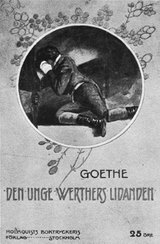The Werther Effect
The year was 1774, and a specter was haunting Europe—a rash of disturbing, elaborate suicides. The culprit? Authorities blamed a popular new novel, Johann Wolfgang von Goethe’s The Sorrows of Young Werther, in which the title character commits suicide out of despair over his impossible love for a married woman. The accusation held water: young men dressed in Werther’s distinctive yellow waistcoat and then, in a darker imitation of the title character, shot themselves in the head. Some even died with the book in hand. The trend sparked widespread panic: Denmark, Italy, and the city of Leipzig banned the novel altogether. To this day, the idea that a piece of art or highly publicized news story can lead to socially motivated “copycat” suicides is still called “the Werther effect.”
Goethe, for his part, was horrified by the suicides of readers. “My friends,” he said, “thought that they must turn poetry into reality, imitate a novel like this in real life and, in any case, shoot themselves.” But the distinction between poetry and reality, between art and life, is crucial to understanding Goethe’s novel and its operatic adaptation. Both works are products of Romanticism: where Enlightenment philosophers such as Locke, Hobbes, and Descartes prioritized rationality, the Romantics reacted against Enlightenment thought by embracing intuition, emotion, and individuality. Romantic artists and philosophers protested what they saw as the Enlightenment’s demystification and exploitation of the natural world. Nature, for the Romantics, held the power to connect man to the sublime. If the Enlightenment fostered social reform and political revolution—as we see (on page 29) in Beaumarchais’s Le mariage de Figaro—the vocation of a Romantic-era artist and thinker was to seek transcendence through the embrace of nature, emotion, and art.
This is an important aspect of the cultural context surrounding the perhaps confusing and unsettling actions of the title character. For most of European history, the common individual held little importance in art, philosophy, or politics, while cultural art focused instead on the upper rungs of society—royals and aristocrats—or represented literary archetypes instead of psychologically complex individuals. Medieval mysteries and morality plays personified abstract concepts such as Love, Death, Good Deeds, or Fellowship. Pre-Romantic literature tended to represent internal psychology only in allegoric ways, such as in Chaucer’s Canterbury Tales or Dante’s Divine Comedy, not in realistic explorations of an individual’s mind. During the 18th century, however, a shift took place: the novel emerged as a distinctive literary form containing nuanced depictions of characters’ internal lives. Psychological realism had arrived.
Massenet’s Werther turns the emotional urgency of Goethe’s novel into a musical and dramatic tour-de-force.

Published in 1774, Goethe’s The Sorrows of Young Werther was, in many ways, a work ahead of its time. Part of the German literary movement Sturm und Drang (Storm and Angst), Goethe’s novel reacted to the rationalism of the Enlightenment well before later Romantics. It delved into—even reveled in—the extremes of human emotion at a time when detailed depictions of characters’ internal lives were still relatively new, and readers couldn’t get enough. Goethe’s star quickly rose following the novel’s publication. But then the copycat suicides attributed to “Werther fever” began. As music’s movements always tend to follow literature’s, opera experienced its own Romantic movement in the century following. Orchestras swelled, composers chafed against formalities, and passions ran high. Completed in 1887 and premiered in 1892, Massenet’s Werther turns the emotional urgency of Goethe’s novel into a musical and dramatic tour-de-force.
Two and a half centuries later, Werther’s story still holds power; the extremes of Werther’s obsession, depression, and final action still captivate. But those same extremes, in the context of a more lighthearted and detached 21st-century culture, can also frustrate and confuse: why does he take it that far? What’s the point? It’s easy to be flippant when presented with a character who acts in ways we would not. Should we think of Werther’s suicide as realistic, or is it an artistic expression of the tormented Romantic individual? His passions are represented in exquisite, extreme detail, and he drives himself to suffer because his tortured emotions are paths to Romantic transcendence. But what should the tormented Romantic individual mean to us today? Like the best in art, Werther resists easy assessments of right and wrong, should or shouldn’t; we can walk away with any number of emotional responses to his actions. But perhaps we can look to Goethe, as he wrote in the novel’s opening lines: “thou, good soul, who sufferest the same distress… draw comfort from his sorrows; and let this little book be thy friend.”